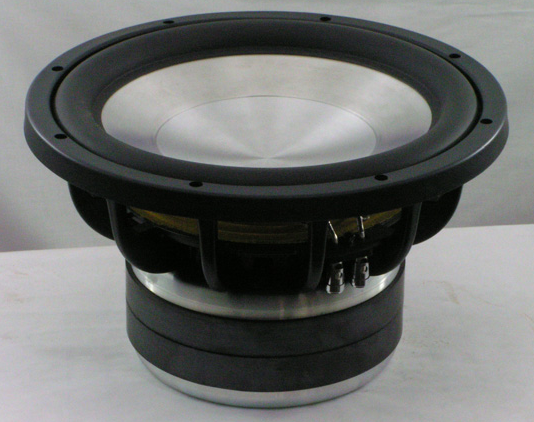Introducing the AV15
Acoustic Elegance have a range of woofers and subwoofers with advanced motor designs. The AV series feature high excursion (23mm one way xmax), high power handling and low inductance.
What can we do with this driver?
For an LFE sub, we have a few choices:
- sealed
- vented
- 6th order bandpass
- tapped horn
- front loaded horn
We'll power this sub with a popular pro audio amplifier - Behringer Europower EP4000. It's maximum power output when bridged is 2.4kw into a 4 ohm load or 2 x 950w into dual 4 ohm loads with a more conservative rating.
Conventional options
Here are the main conventional options - sealed (blue), vented (red) and 6th order bandpass (magenta).
You can see the sealed box doesn't stand a chance for LFE use. 106 db isn't bad, but it's not impressive when 120 db is available. All of them simulated within the excursion limts, as shown below:
In each case, a rumble filter was used at 20 Hz to keep excursion under control. The bandpass has slightly better efficiency and hence a little more output, but considering the extra size and difficulty, it's hardly worth getting excited about.
Now for some horns. First a tapped horn:
Around 3db extra output is possible compared to the vented box. While this might not be as much as we might hope for, greater extension can be achieved.
If we're prepared to upsize it, then a front loaded horn blows everything else away.
The horn is huge. The mouth is 63 times the cone piston area, or 2.7m high (8 ft) by 1.9m wide (6 ft). This can only work as a built-in horn. The make it a fair match to the other simulations, I've simulated the horn without the benefit of corner loading, hence the ripples. However, in a corner this horn will be flat in response. In reality, this horn could be reduced in size.
Conclusion
If you are looking for a killer LFE sub, you can rule out the sealed box. It's the expensive way to get the job done and it doesn't pay to be put off by those who claim vented boxes are "slow." The vented box wins in terms of reward for effort. It can hit 120 dB with just one driver and if that's not enough, simply build more of them. Four of them will reach 130 dB. In a real room you may get more or less depending on the specific acoustic properties of your room.
The tapped horn in this case doesn't seem to offer a great deal more than the vented box. Along with a bandpass, it's still worth considering but you will need to be prepared for something very big. Chances are it will be bigger than you can live with, so you might want to think about where you can hide it.
If you want something extreme, then it's hard to go past the massive built-in horn. If you make it big enough, it will win every time. Just one driver with one amp will probably beat four drivers running on at least twice as much power. Using more drivers can push the output up to 140 dB. At this point it starts to sound ridiculous, but the point isn't winning an SPL competition, but being able to play as loud as you want with a lot of headroom. You might find that you only hit 115 dB peaks at your listening position, which is the THX reference, with 105 dB in the midrange. This won't cause your ears to bleed on a system well designed for reference levels and it won't damage your hearing. A movie played at this level will have a typical level that is perfectly safe. If you play music all the time with 115 dB in the midrange, then you will have problems.






how can I get an AV15? Looks like AE no longer sells them.
ReplyDeleteIt's a bit unfortunate that some good options like this and Exodus drivers have dropped. There are still good options out there.
ReplyDelete